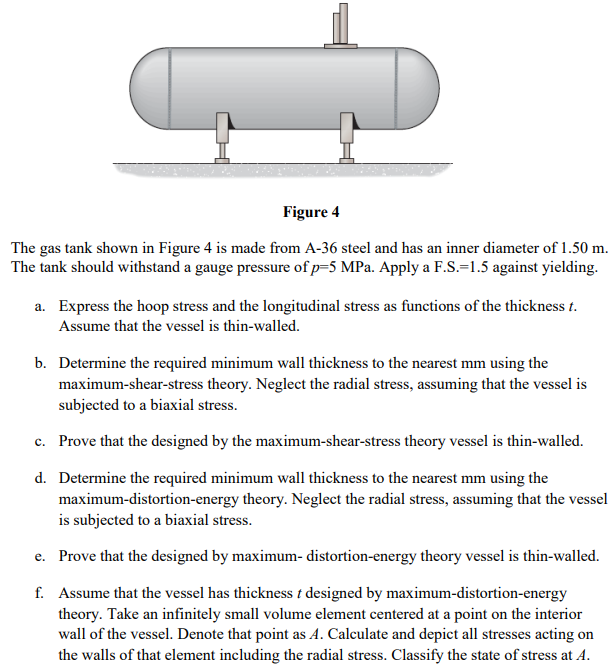The gas tank shown in Figure 4 is made from A-36 steel and has an inner diameter of 1.50 m The tank should withstand a gauge pressure of p-5 MPa. Apply a F.S.=1.5 against yielding. a. Express the hoop stress and the longitudinal stress as functions of the thickness t. Assume that the vessel is thin-walled. b. Determine the required minimum wall thickness to the nearest mm using the maximum-shear-stress theory. Neglect the radial stress, assuming that the vessel is subjected to a biaxial stress. c. Prove that the designed by the maximum-shear-stress theory vessel is thin-walled.
The gas tank shown in Figure 4 is made from A-36 steel and has an inner diameter of 1.50 m The tank should withstand a gauge pressure of p-5 MPa. Apply a F.S.=1.5 against yielding. a. Express the hoop stress and the longitudinal stress as functions of the thickness t. Assume that the vessel is thin-walled. b. Determine the required minimum wall thickness to the nearest mm using the maximum-shear-stress theory. Neglect the radial stress, assuming that the vessel is subjected to a biaxial stress. c. Prove that the designed by the maximum-shear-stress theory vessel is thin-walled.
Mechanics of Materials (MindTap Course List)
9th Edition
ISBN:9781337093347
Author:Barry J. Goodno, James M. Gere
Publisher:Barry J. Goodno, James M. Gere
Chapter8: Applications Of Plane Stress (pressure Vessels, Beams, And Combined Loadings)
Section: Chapter Questions
Problem 8.5.32P
Related questions
Question

Transcribed Image Text:Figure 4
The gas tank shown in Figure 4 is made from A-36 steel and has an inner diameter of 1.50 m.
The tank should withstand a gauge pressure of p-5 MPa. Apply a F.S.=1.5 against yielding.
a. Express the hoop stress and the longitudinal stress as functions of the thickness t.
Assume that the vessel is thin-walled.
b. Determine the required minimum wall thickness to the nearest mm using the
maximum-shear-stress theory. Neglect the radial stress, assuming that the vessel is
subjected to a biaxial stress.
c. Prove that the designed by the maximum-shear-stress theory vessel is thin-walled.
d. Determine the required minimum wall thickness to the nearest mm using the
maximum-distortion-energy theory. Neglect the radial stress, assuming that the vessel
is subjected to a biaxial stress.
e.
Prove that the designed by maximum- distortion-energy theory vessel is thin-walled.
f. Assume that the vessel has thickness t designed by maximum-distortion-energy
theory. Take an infinitely small volume element centered at a point on the interior
wall of the vessel. Denote that point as A. Calculate and depict all stresses acting on
the walls of that element including the radial stress. Classify the state of stress at 4.
Expert Solution
This question has been solved!
Explore an expertly crafted, step-by-step solution for a thorough understanding of key concepts.
Step by step
Solved in 4 steps

Knowledge Booster
Learn more about
Need a deep-dive on the concept behind this application? Look no further. Learn more about this topic, mechanical-engineering and related others by exploring similar questions and additional content below.Recommended textbooks for you

Mechanics of Materials (MindTap Course List)
Mechanical Engineering
ISBN:
9781337093347
Author:
Barry J. Goodno, James M. Gere
Publisher:
Cengage Learning

Mechanics of Materials (MindTap Course List)
Mechanical Engineering
ISBN:
9781337093347
Author:
Barry J. Goodno, James M. Gere
Publisher:
Cengage Learning